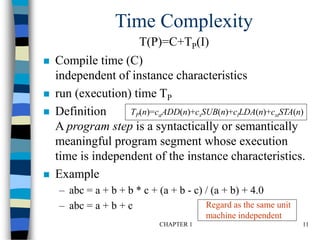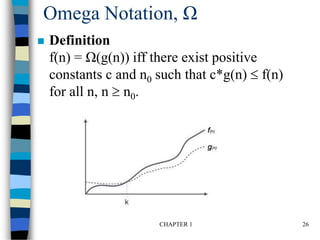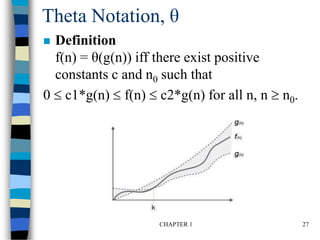This document discusses key concepts in algorithm analysis and design including algorithms, data types, specifications vs implementations, time and space complexity analysis, asymptotic notation, and examples. It defines an algorithm as a set of instructions to accomplish a task, and a data type as a collection of objects and operations on those objects. The document covers analyzing time complexity using counting steps and asymptotic notation such as Big O, Omega, and Theta. Examples of matrix and list functions and their analyses are provided.








![CHAPTER 1 9
*Program 1.9: Simple arithmetic function (p.19)
float abc(float a, float b, float c)
{
return a + b + b * c + (a + b - c) / (a + b) + 4.00;
}
*Program 1.10: Iterative function for summing a list of numbers (p.20)
float sum(float list[ ], int n)
{
float tempsum = 0;
int i;
for (i = 0; i<n; i++)
tempsum += list [i];
return tempsum;
}
Sabc(I) = 0
Ssum(I) = n+3](https://image.slidesharecdn.com/chapter1-230730133811-0ebca271/85/chapter1-ppt-9-320.jpg)
![CHAPTER 1 10
*Program 1.11: Recursive function for summing a list of numbers (p.20)
float rsum(float list[ ], int n)
{
if (n) return rsum(list, n-1) + list[n-1];
return 0;
}
*Figure 1.1: Space needed for one recursive call of Program 1.11 (p.21)
Type Name Number of bytes
parameter: float
parameter: integer
return address:(used internally)
list [ ]
n
2
2
2(unless a far address)
TOTAL per recursive call 6
Ssum(I)=Ssum(n)=6n
Assumptions:](https://image.slidesharecdn.com/chapter1-230730133811-0ebca271/85/chapter1-ppt-10-320.jpg)


![CHAPTER 1 13
*Program 1.12: Program 1.10 with count statements (p.23)
float sum(float list[ ], int n)
{
float tempsum = 0; count++; /* for assignment */
int i;
for (i = 0; i < n; i++) {
count++; /*for the for loop */
tempsum += list[i]; count++; /* for assignment */
}
count++; /* last execution of for */
return tempsum;
count++; /* for return */
}
2n + 3 steps
Iterative summing of a list of numbers](https://image.slidesharecdn.com/chapter1-230730133811-0ebca271/85/chapter1-ppt-13-320.jpg)
![CHAPTER 1 14
*Program 1.13: Simplified version of Program 1.12 (p.23)
float sum(float list[ ], int n)
{
float tempsum = 0;
int i;
for (i = 0; i < n; i++)
count += 2;
count += 3;
return 0;
}
2n + 3 steps](https://image.slidesharecdn.com/chapter1-230730133811-0ebca271/85/chapter1-ppt-14-320.jpg)
![CHAPTER 1 15
*Program 1.14: Program 1.11 with count statements added (p.24)
float rsum(float list[ ], int n)
{
count++;
if (n) {
count++;
return rsum(list, n-1) + list[n-1];
}
count++;
return list[0];
}
2n+2
Recursive summing of a list of numbers](https://image.slidesharecdn.com/chapter1-230730133811-0ebca271/85/chapter1-ppt-15-320.jpg)
![CHAPTER 1 16
*Figure 1.2: Step count table for Program 1.10 (p.26)
Statement s/e Frequency Total steps
float sum(float list[ ], int n)
{
float tempsum = 0;
int i;
for(i=0; i <n; i++)
tempsum += list[i];
return tempsum;
}
0 0 0
0 0 0
1 1 1
0 0 0
1 n+1 n+1
1 n n
1 1 1
0 0 0
Total 2n+3
Tabular Method
steps/execution
Iterative function to sum a list of numbers](https://image.slidesharecdn.com/chapter1-230730133811-0ebca271/85/chapter1-ppt-16-320.jpg)
![CHAPTER 1 17
*Figure 1.3: Step count table for recursive summing function (p.27)
Statement s/e Frequency Total steps
float rsum(float list[ ], int n)
{
if (n)
return rsum(list, n-1)+list[n-1];
return list[0];
}
0 0 0
0 0 0
1 n+1 n+1
1 n n
1 1 1
0 0 0
Total 2n+2
Recursive Function to sum of a list of numbers](https://image.slidesharecdn.com/chapter1-230730133811-0ebca271/85/chapter1-ppt-17-320.jpg)
![CHAPTER 1 18
*Program 1.18: Printing out a matrix (p.28)
void print_matrix(int matrix[ ][MAX_SIZE], int rows, int cols)
{
int i, j;
for (i = 0; i < row; i++) {
for (j = 0; j < cols; j++)
printf(“%d”, matrix[i][j]);
printf( “n”);
}
}
Exercise 1](https://image.slidesharecdn.com/chapter1-230730133811-0ebca271/85/chapter1-ppt-18-320.jpg)
![CHAPTER 1 19
*Program 1.19:Matrix multiplication function(p.28)
void mult(int a[ ][MAX_SIZE], int b[ ][MAX_SIZE], int c[ ][MAX_SIZE])
{
int i, j, k;
for (i = 0; i < MAX_SIZE; i++)
for (j = 0; j< MAX_SIZE; j++) {
c[i][j] = 0;
for (k = 0; k < MAX_SIZE; k++)
c[i][j] += a[i][k] * b[k][j];
}
}
Exercise 2](https://image.slidesharecdn.com/chapter1-230730133811-0ebca271/85/chapter1-ppt-19-320.jpg)
![CHAPTER 1 20
*Program 1.20:Matrix product function(p.29)
void prod(int a[ ][MAX_SIZE], int b[ ][MAX_SIZE], int c[ ][MAX_SIZE],
int rowsa, int colsb, int colsa)
{
int i, j, k;
for (i = 0; i < rowsa; i++)
for (j = 0; j< colsb; j++) {
c[i][j] = 0;
for (k = 0; k< colsa; k++)
c[i][j] += a[i][k] * b[k][j];
}
}
Exercise 3](https://image.slidesharecdn.com/chapter1-230730133811-0ebca271/85/chapter1-ppt-20-320.jpg)
![CHAPTER 1 21
*Program 1.21:Matrix transposition function (p.29)
void transpose(int a[ ][MAX_SIZE])
{
int i, j, temp;
for (i = 0; i < MAX_SIZE-1; i++)
for (j = i+1; j < MAX_SIZE; j++)
SWAP (a[i][j], a[j][i], temp);
}
Exercise 4](https://image.slidesharecdn.com/chapter1-230730133811-0ebca271/85/chapter1-ppt-21-320.jpg)





